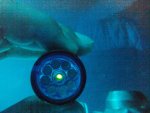Blade
0
- Joined
- Apr 4, 2010
- Messages
- 86
- Points
- 0
hey everyone, of course ive been into the laser hobby for some time now and i feel like a noob asking about this. but i looked and searched the forum quite a bit before posting this to make sure it wasnt already discussed, ive found nothing... anyway, i was messing around with an 8 LED / 5mw 650nm red laser i bought from radioshack when i decided to shine it through a few things (glass, sunglasses etc. ) but i knew blue absorbs red light best, so i shined it through a solution of simple copper acetate i made a while back. at first glance i noticed absolutely NO light was coming through. but i moved around and came across i guess the direct center of the diode and noticed a faint but noticeable light... it was green! i checked this a few times and even turned the lights off to see if it was some sort of stray reflection off of something else. but it was in fact coming from the laser! now, my noob question is: 1) what is this light? if the wavelegnth is red, 2) why is green showing? to my knowledge red and blue make purple lol... so theres some pix too. and i have a video and will post it if needed as well 
btw, i didnt really know where to post this thread, so i posted it here since i thought it best matched the topic.
hope i can get some answers thanx
thanx
the photos are of me trying to align the camera and laser (in sequence)
btw, i didnt really know where to post this thread, so i posted it here since i thought it best matched the topic.
hope i can get some answers
the photos are of me trying to align the camera and laser (in sequence)
Attachments
Last edited:


![P201211_23.56_[02].jpg](/data/attachments/22/22672-8debbc5e6f81dee78de2ff9ea60f8d66.jpg)
![P201211_23.56_[01].jpg](/data/attachments/22/22673-738b745a9e649662bee488c0ddbdffa9.jpg)
![P201211_23.55_[01].jpg](/data/attachments/22/22674-7bbd2170052ced0ac2d7e896bbd6d374.jpg)
![P201211_23.55_[02].jpg](/data/attachments/22/22675-470282e04e45003c2a4c66db8e60d3f8.jpg)




